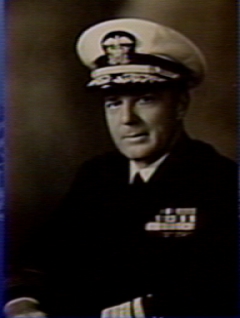MERRILL-AARON
AARON STANTON "TIP" MERRILL

VADM

A DISTINGUISHED NAVAL CAREER
Aaron Stanton Merrill was born on March 26, 1890 in Natchez, Mississippi. He entered the U.S. Naval Academy in 1908 and graduated with the class of 1912. His first assignment was in the Mediterranean Sea aboard the destroyer USS Aylwin (DD-47), based in Plymouth, England. During the last months of World War One, he commanded the patrol craft USS Harvard (SP-209) based at Harwich, England. In late 1919, Merrill served on the staff of the U.S. High Commissioner to Turkey and Commander of U.S. Naval Forces in the Eastern Mediterranean. In 1925 he commanded the gunboat USS Elcano (PG-38) on the Yangtze Patrol. This was followed by two years at the Office of Naval Intelligence in Washington, DC, before assuming command in 1929 of the destroyer USS Williamson (DD-244). Promoted to rank of commander in 1932, he spent another year in the Office of Naval Intelligence before assignment as Aide to the Assistant Secretary of the Navy.
In June 1935, Merrill was assigned to the heavy cruiser USS Pensacola (CA-24) and received the Order of the Crown from the Belgian Government, after conveying the remains of Paul May, Belgian Ambassador to the United States, back to Antwerp. From June 1936 he commanded Destroyer Division Eight, then served as Naval Attaché at the American Embassy in Santiago, Chile. In this assignment he cruised extensively with the Chilean Navy, becoming the first foreigner to round the Horn in a Chilean warship. For his services he was awarded the Chilean Order of Merit. After study at the Naval War College in Newport, he was promoted to Captain and given command of a Destroyer Division in the Pacific with the USS Somers (DD-381) as his flagship.
During the early months of World War Two, Captain Merrill taught naval science at Tulane University until assignment as the commander of the battleship USS Indiana (BB-58). After promotion to Rear Admiral in January 1943, he led a cruiser-destroyer task force participating in the Battle of Guadalcanal and would later win distinction during the Bougainville campaign for his success defending against an assault by the Japanese fleet in a hard-fought night battle. In March 1943, during the Solomon Island campaign, he was the first to introduce the use of radar against enemy naval forces at the Battle of Kula Gulf. For this he received both the Legion of Merit and the Navy Cross. He served as Director of the Office of Public Relations for the Navy Department during 1944-1945, until joining a diplomatic delegation to meet with members of the Chilean government to discuss mutual defense policies. His efforts to establish an American naval mission to Chile in place of the former British presence earned him the title of Grand Officer of the Order of Merit by Chile. In June 1946, after a short assignment as Commandant of the Eighth Naval District, he assumed command of Gulf Sea Frontier and remained in this assignment until retiring in November 1947.
VADM Aaron Stanton Merrill died on February 28, 1961 and is buried at Natchez City Cemetery in Natchez, Mississippi. The USS Merrill (DD-976) was named in his honor and served from 1976 to 1998. Following his death, VADM Merrill left a collection of approximately 3,600 official and personal papers, principally concerning his career in naval intelligence. The archival material is held for researchers in the Wilson Library at the University of North Carolina at Chapel Hill.
NAVY CROSS CITATION
The President of the United States of America takes pleasure in presenting the Navy Cross to Rear Admiral Aaron Stanton Merrill, United States Navy, for extraordinary heroism and distinguished service in the line of his profession as Commander, Task Force THIRTY-NINE (TF-39), during an engagement with Japanese naval forces at Empress Augusta Bay, off Bougainville, Solomon Islands, on the night of 1 - 2 November 1943. Employing daring tactics with gunfire and torpedoes, Rear Admiral Merrill disposed his ships with such skill that the ensuing battle resulted in the destruction of five hostile warships, including one cruiser and four destroyers. During the retirement from this action, his forces repulsed an air attack by 67 Japanese planes, shooting down 17 of them. Rear Admiral Merrill's inspiring leadership and the valiant devotion to duty of his command contributed in large measure to the outstanding success of these vital missions and reflect great credit upon the United States Naval Service.
Submitted by CDR Roy A. Mosteller, USNR (Ret)

